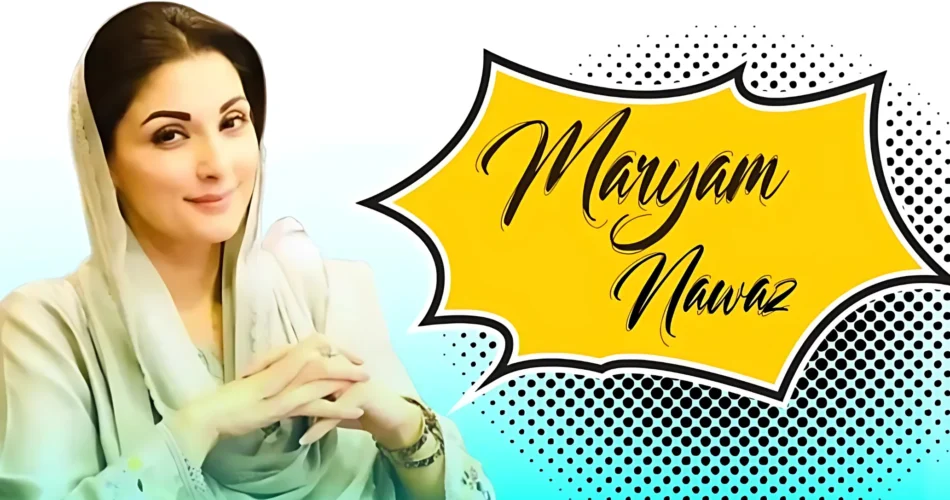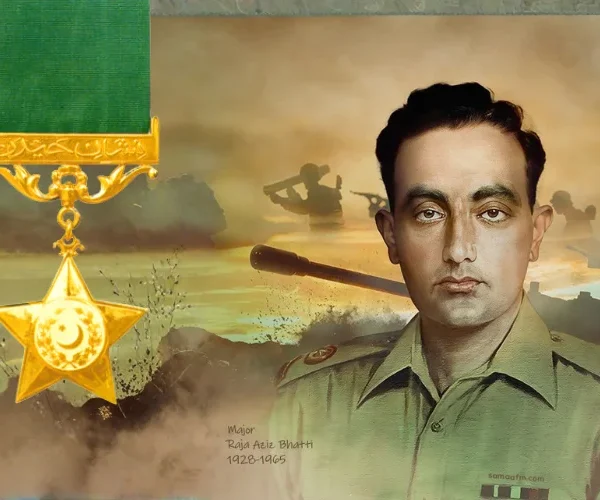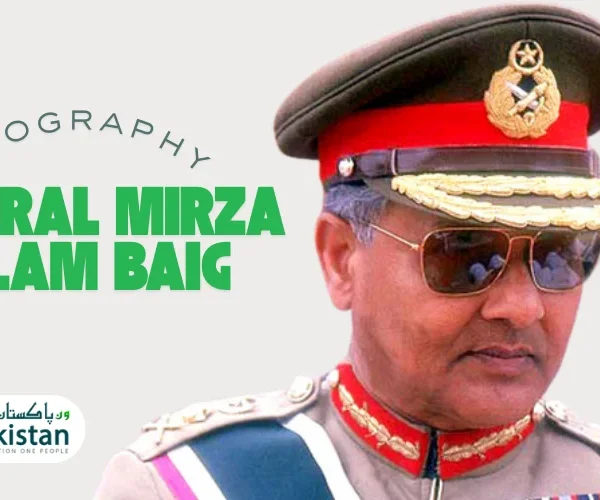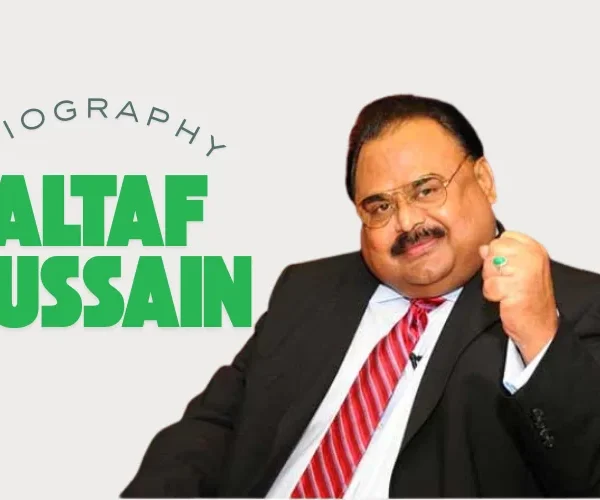Maryam Nawaz Sharif is a Pakistani politician and the first woman to become Chief Minister of Punjab. She stepped into this role in February 2024, marking a new chapter in her family’s long political journey.
Full name: Maryam Nawaz Sharif, also known as Maryam Safdar
Date of birth: 28 October 1973, Lahore
Age: 51 (as of 2025)
Current office: Chief Minister of Punjab
Constituency: PP-159 Lahore XV
Political party: Pakistan Muslim League (Nawaz)
Spouse: Muhammad Safdar Awan
Children: Mehr-un-Nisa, Junaid, Mahnoor
Education: Reportedly holds a master’s degree in English literature from the University of the Punjab
Early Life and Family Background
Maryam Nawaz was born in Lahore on 28 October 1973 into one of Pakistan’s most influential political families. She is the daughter of Nawaz Sharif, the three-time Prime Minister of Pakistan, and Kulsoom Nawaz, who was known for her grace and resilience, particularly during times of political upheaval. Growing up in this environment meant politics and public service were always part of her surroundings.
She is the second of four siblings and spent much of her early life within the close-knit Sharif family. Her grandfather, Muhammad Sharif, was a prominent industrialist whose business ventures laid the foundation for the family’s wealth and influence. These early experiences exposed Maryam not only to privilege but also to the expectations that come with carrying a powerful family name.
Despite the demands of her father’s political career, Maryam’s mother ensured that the children received a stable upbringing. Maryam has often spoken about her admiration for her mother’s strength, which played a major role in shaping her outlook on life. Her upbringing combined traditional values with exposure to the public sphere, preparing her for the responsibilities she would later take on in both family and politics.
As she grew older, her interests expanded beyond family life. Maryam showed a strong inclination toward academics and social causes, hinting at the role she would eventually carve for herself. This natural curiosity and sense of responsibility led her to pursue higher education with dedication.
Education and Qualifications
Maryam Nawaz grew up in Lahore and attended well known city schools where she built a strong base in languages and public speaking. Her early education combined classroom learning with the kind of civic exposure that comes from a politically active family.
Schools and early learning
She received her schooling in Lahore, with Convent of Jesus and Mary often noted in profiles of her early life. Teachers and peers remember her for confident expression and debate, traits that later shaped her political voice.
Higher education
Maryam Nawaz is widely reported to have completed a master’s degree in English literature from the University of the Punjab. The focus on literature and communication shows up in her speeches and interviews, where she relies on clear phrasing and narrative structure rather than technical jargon.
Professional development
Much of her practical learning came from inside the party. She spent years observing policy briefings, planning campaign outreach, and handling media interactions. That apprenticeship gave her a working knowledge of constituency management, message discipline, and stakeholder engagement long before she held executive office.
Skills relevant to public office
- Communication and public messaging
- Team leadership and cabinet coordination
- Constituency outreach and service delivery tracking
- Policy translation into simple, actionable goals for departments
Personal life
Maryam Nawaz married Muhammad Safdar Awan in 1992 in Lahore. He is a retired army captain and later served in elected office, which kept the family closely connected to public life. Together they have three children named Mehr un Nisa, Junaid, and Mahnoor.
Marriage and family
Her marriage brought together two households already familiar with public service. While Maryam’s schedule often revolves around politics and administration, she has described family as the anchor that keeps her routine grounded. Major family events are usually kept private, with occasional appearances at party or charitable gatherings.
Children
- Mehr un Nisa has been seen at important family occasions and is often mentioned in profiles that track the Sharif family timeline.
- Junaid pursued studies and early career steps away from the spotlight for long stretches.
- Mahnoor is the youngest and appears less frequently in public reporting.
Personal interests and routine
Accounts from colleagues and long time observers describe Maryam as disciplined about preparation, especially before speeches and policy briefings. Reading, note making, and rehearsal are regular parts of her day. She has also supported charitable work linked to education and health drives when official schedules allow.
Privacy and public role
Given the family’s prominence, privacy is a recurring concern. Public communication focuses on policy and political messaging, while personal details such as contact numbers or private schedules are not shared. For readers searching Maryam Nawaz husband name, Maryam Nawaz daughter, or Maryam Nawaz children, the key facts are covered above without exposing private information.
Entry into politics
Maryam Nawaz’s path into public life began inside the party rather than from an elected seat. She first appeared as a visible campaigner, speaking at town halls and student events, and coordinating outreach for the party’s message. This is where many observers first answered the question who is Maryam Nawaz in a political sense. She was the voice introducing policies in plain language and the organiser keeping teams on schedule.
Early public role
Her initial assignments focused on youth engagement, volunteer drives, and media coordination. She learned how constituency issues translate into talking points, and how to shape a schedule that keeps candidates close to voters. Colleagues describe this period as her on the ground training in politics.
Campaign and outreach
During national and provincial election cycles she took on a larger stage presence. Speeches, press briefings, and digital messaging became regular parts of her work. She built a style that mixes personal stories with policy lines, which helped her connect with audiences beyond party loyalists.
Organisational responsibilities
Over time she moved from campaign surrogate to a recognised organiser inside PML N. Senior roles followed, giving her authority over message discipline, field coordination, and event strategy. This was the bridge from public advocate to party leader in her own right.
Voice and strategy
Maryam Nawaz positioned herself as a communicator who can carry complex issues in simple words. She leans on preparation and repetition, using clear themes in both Urdu and English. That consistency made her one of the most watched figures in the party and set expectations that she would eventually seek executive office.
What this phase set up
By the time she contested a provincial seat, she had already logged years of planning briefings, rally routes, and media interactions. The experience created a foundation in three areas that define her leadership today. Message clarity, team coordination, and a focus on service delivery that voters can see.
Leadership and offices
Maryam Nawaz moved from campaign leader to public office when she became Chief Minister of Punjab in February 2024. As the first woman to hold this position, she leads the province’s executive and sets the direction for departments through the Punjab Cabinet and the Chief Minister’s Office.
Provincial leadership
Her day to day work centres on cabinet meetings, administrative briefings, and reviews with secretaries of key departments such as health, education, local government, and finance. The focus is on turning party promises into department targets and then tracking how those targets land at the district level.
Assembly mandate
She sits in the Punjab Assembly and uses that platform to present policy outlines, budget priorities, and timelines for delivery. The assembly setting also anchors oversight, where questions from members shape follow up actions by departments.
Party role
Before taking office she spent years shaping the party’s message and campaign calendar. That organisational experience now supports governance, especially when aligning political goals with administrative capacity across districts.
How she manages the cabinet
Colleagues describe a routine built around preparation. Brief notes before meetings, clear action points after, and regular follow up huddles with principal staff officers. The aim is to keep decisions simple, responsibilities visible, and progress measurable.
Early administrative priorities
- Quick wins that citizens can feel in health, transport, and citizen services
- Youth focused schemes that mix skills, access to tools, and small business support
- Social protection updates that work with CNIC based verification
- Improvements in service delivery through digital tracking and helplines
Working style
Maryam Nawaz tends to combine stage communication with back room detail. Public speeches set the tone, while internal notes translate the tone into tasks for departments. District visits and review sessions keep pressure on timelines, which is where most delivery efforts succeed or stall.
Flagship initiatives and programs
This section gives a neutral overview of programmes commonly linked to Maryam Nawaz as Punjab Chief Minister. Names, rules, and timelines can change, so always verify the current window before you apply.
Loan scheme
The loan scheme targets young people and women who want to start or expand small businesses. Typical steps include checking eligibility, filling an online form, uploading CNIC and basic business details, and completing verification through partner banks. Training or mentorship may be attached for first time borrowers. Search interest often appears as Maryam Nawaz loan scheme and loan scheme apply online, which you can use to find the latest application window.
Bike scheme for students
The student bike scheme is designed to improve access to campuses and internships. Applicants usually need proof of enrollment, a valid CNIC, domicile in Punjab, and a learner’s permit. Allocation can happen in phases or by balloting, and repayments are scheduled in monthly installments. You will see this referred to as Maryam Nawaz bike scheme in most searches.
Laptop scheme
The laptop scheme focuses on university students who meet academic or need based criteria set in the announcement. A portal based form, university verification, and merit lists are common parts of the process. If you track Maryam Nawaz laptop scheme, look for clear eligibility lines and a published shortlist before collection.
Ramzan relief
During Ramzan, the province has announced short term relief for low income households. Search trends call this Maryam Nawaz Ramzan package or 10000 Ramzan package. The exact amount, eligibility rules, and distribution method depend on the year’s notification. Beneficiaries are typically verified by CNIC and guided to collection points or approved wallets.
Ration and price support
Some relief cycles include ration subsidies through notified outlets. Users search for Maryam Nawaz rashan program and rashan program CNIC check online when a window opens. Eligibility checks rely on CNIC and existing household data. Distribution may be limited to a published list of districts or shops for each phase.
Youth and skills add ons
Alongside headline schemes, the administration has spoken about short courses, apprenticeships, and fee support to help young people move into work. When these appear, expect a CNIC based sign up, a training provider list, and attendance requirements linked to certification.
How to approach any new announcement
- Read the latest notice for eligibility, last date, and required documents
- Use your own CNIC and phone for any online form or code based check
- Save your reference number and a screenshot of each step
- Avoid agents who offer guaranteed seats or shortcuts
Policy priorities
Maryam Nawaz sets out her agenda in simple themes that voters can track. The aim is to tie big goals to visible changes at the district level.
Women’s empowerment
Focus on access to education, health, safety, and credit so more women can study, work, and start small businesses. This links to schemes that reduce travel barriers and provide targeted financial support.
Youth and skills
Training, internships, and entry level financing help young people move from study to work. Merit based lists, attendance rules, and basic coaching improve completion and placement.
Education
Priority on school facilities, teacher availability, and college access. University focused programmes look at scholarships, devices for study, and better connectivity so students can use digital resources.
Health
Upgrades to hospitals and basic health units, with attention to emergency care, mother and child services, and medicine availability. Monitoring checks whether promised staff, equipment, and supplies reach each facility.
Social protection
CNIC based targeting keeps assistance focused on low income households. Coordinated windows during Ramzan or special relief cycles help families manage rising costs.
Infrastructure and transport
Smaller fixes such as road patching and lighting sit alongside larger public transport improvements. The goal is to cut commute time and improve safety for students and workers.
Digital governance
Portals, helplines, and dashboards make it easier to apply, track, and complain. The province continues to expand online forms and status pages so people do not have to visit offices for every request.
Transparency and feedback
Public briefings, district reviews, and complaint redress systems support oversight. Clear timelines and published lists help citizens verify that delivery matches announcements.
How these priorities connect to programmes
- Financial access for women and youth pairs with loan or device schemes
- Student mobility links to bike and transport initiatives
- Relief cycles use CNIC checks to keep support targeted
- Hospital and school upgrades are tracked against simple, published indicators
Timeline
A clear timeline makes her journey easy to follow. Here are the milestones that most readers search first.
Early years
- 1973
Born in Lahore on 28 October - School and college
Educated in Lahore, with a focus on languages and public speaking - Higher studies
Reported master’s degree in English literature from the University of the Punjab
Family and public life
- 1992
Married Muhammad Safdar Awan - Late 1990s and 2000s
Active around family charities and public events while the Sharif family moved through long political cycles
Rising political profile
- 2012 to 2013
Visible in campaigns and youth outreach, increasingly a public voice for the party - 2013 to 2014
Took on a national youth programme role, then stepped aside amid debate about the appointment
Legal headwinds and return
- 2016 to 2018
Faced high profile court cases during the Panama Papers period and continued campaign work - Mid 2018
Convicted in the Avenfield reference before the general election, later released on court orders pending appeal - 2019
Arrested in a separate inquiry and granted bail the same year - 2022
Acquitted by the Islamabad High Court in the Avenfield case, clearing a major legal hurdle
Party leadership and executive office
- January 2023
Named Senior Vice President and Chief Organizer of PML N, which formalised her organising role - Late 2023
Led extensive campaign events across Punjab - February 2024
Elected to the Punjab Assembly and chosen as Chief Minister of Punjab, the first woman to hold the office
Governance focus
- 2024 to 2025
Rolled out or advanced headline items often searched by name, including a loan scheme for small businesses, a student bike plan, a laptop programme tied to university enrolment, Ramzan relief, and ration support windows - Ongoing
Emphasis on women’s empowerment, youth and skills, upgrades in health and education, and wider use of portals and helplines for services
Public image and media
Maryam Nawaz has built a public profile around clear messaging, frequent appearances, and a steady digital presence. Her audience cuts across age groups in Punjab, with strong interest from students and first-time voters.
Communication style
She prefers plain language and short sentences in both Urdu and English. Most speeches mix policy points with a personal story, which keeps the message easy to follow. Repetition of key lines is deliberate so audiences leave with one or two takeaways.
Rallies and speeches
Large rallies across Punjab remain central to her outreach. Speeches often highlight service delivery, women’s participation, and youth opportunities. Search interest around Maryam Nawaz speeches reflects how clips from these events circulate quickly after each stop.
Social media presence
Her team posts frequent updates, short video clips, and event schedules on major platforms. Supporters follow for policy announcements, while critics watch for quick responses to breaking news. Queries like Maryam Nawaz tweet today or social media presence rise during campaign cycles and budget weeks.
Media strategy
Press briefings and interviews are used to set the frame on policy debates. The approach pairs a headline claim with a concrete action, such as a portal opening or a new district target. Digital teams then package these points into short posts for wider reach.
Support and criticism
Backers cite visibility, message discipline, and a focus on women and youth. Critics question dynastic politics or revisit legal cases from previous years. Both views shape her media environment, which is why fact sheets, timelines, and dated updates matter for readers.
Visual identity
Public appearances tend to keep a consistent, formal look. Photos from cabinet rooms and district visits are used to underline the day’s message rather than personal branding.
How readers can stay accurate
Note the date on any clip or quote. Compare a headline with the most recent budget note or department update before sharing. Save a screenshot with the time stamp if you plan to reference it later.
Frequently searched facts
People often look for quick answers on age, date of birth, height, education, and family. Here is a clean, accurate set you can rely on.
Age and date of birth
- Date of birth is 28 October 1973, Lahore.
- Age today is 51 as of August 2025.
- Age in 2024 was 50.
- Age in 2023 was 49.
Height and height in feet
- No official height has been published.
- Figures you see online are estimates. Treat them as unverified.
Education and qualification
- Commonly reported as holding a master’s degree in English literature from the University of the Punjab.
- Public profiles emphasise strengths in communication, public speaking, and campaign strategy.
Marriage and children
- Married Muhammad Safdar Awan in 1992, Lahore.
- Children are Mehr un Nisa, Junaid, and Mahnoor.
- Age at marriage works out to about 18 or 19, since the exact wedding date within 1992 is not publicly fixed.
Names and variants
- Full name used in public life is Maryam Nawaz Sharif.
- Birth name Maryam Safdar appears in family records and earlier references.
Current public role
- Serves as Chief Minister of Punjab, elected in February 2024.
- Member of the Punjab Assembly from a Lahore constituency.
Controversies and legal matters
Public life for a senior politician often includes court proceedings and inquiries. Here is a short, neutral record of major events with dates and outcomes.
Panama Papers and inquiry period
2016 to 2017 saw the Panama Papers case and a court supervised inquiry into assets linked to the Sharif family. Findings from that process led accountability authorities to file references that later moved through trial and appeal courts. The document authenticity dispute that surfaced during the inquiry remained a point of political debate rather than a court conviction against Maryam Nawaz.
Avenfield Apartments reference
6 July 2018
An accountability court in Islamabad convicted Maryam Nawaz in the Avenfield reference and sentenced her to prison.
19 September 2018
The Islamabad High Court suspended the sentence pending appeal.
29 September 2022
The Islamabad High Court acquitted Maryam Nawaz in the Avenfield case, setting aside the conviction and sentence.
Chaudhry Sugar Mills inquiry
8 August 2019
Maryam Nawaz was arrested by the accountability bureau in connection with the Chaudhry Sugar Mills inquiry.
November 2019
The Lahore High Court granted her bail. As of August 2025, no court has recorded a conviction against her in this matter.
Passports, travel, and bail matters
2019 to 2022 included applications for bail and for the return of travel documents in different proceedings. Courts granted relief at various stages, allowing travel once the relevant orders were issued.
Electoral eligibility and office
Following the 2022 acquittal in Avenfield and completion of required legal steps, Maryam Nawaz contested provincial elections, took oath as a Member of the Punjab Assembly in February 2024, and was elected Chief Minister of Punjab later that month.
Note
Case statuses can change with new filings or orders. Dates and outcomes above reflect publicly available court records up to August 2025.
Awards and recognition
Public recognition for Maryam Nawaz is tied mainly to political milestones rather than formal prizes. Here is a clear, factual snapshot.
Civic and institutional recognition
- First woman to serve as Chief Minister of Punjab. This remains the most cited milestone in profiles and news coverage.
- Elected Member of the Punjab Assembly from a Lahore constituency before taking office as Chief Minister.
- Appointed Senior Vice President and Chief Organizer of PML-N in 2023, a party level acknowledgment of leadership and organizing work.
Parliamentary and party acknowledgements
- Congratulatory statements from party forums and coalition partners following her election as Chief Minister in February 2024.
- Regular invitations to address large public gatherings, policy briefings, and student events across Punjab, reflecting standing within the party and among supporters.
Media and public recognition
- Frequent national and international media profiles that highlight her role in provincial leadership and her position within the Sharif family.
- High search interest around speeches, initiatives, and policy announcements, which keeps her at the center of public debate.
What is not on record
As of August 2025, there are no widely reported state civil awards specific to Maryam Nawaz. Recognition to date is best understood through elected office, party appointments, and sustained media attention rather than formal honors.
Key quotes and core messages
Maryam Nawaz’s speeches circle a few steady themes. Rather than risk misquoting a single line from a fast-moving news cycle, here are the ideas she repeats most, in plain English and with the context audiences usually hear around them.
Service delivery you can measure
She ties promises to everyday changes at the district level. Roads fixed, clinics staffed, classrooms equipped, helplines that answer. The message is simple. Government should be felt where people live, and progress should show up in data that anyone can check.
Women at the center
A frequent thread is women’s access to education, health, transport, and credit. She frames it as smart policy and basic fairness at the same time. When women move forward, households and local markets follow.
Youth, skills, and first jobs
Students and first-time workers are asked to use training windows, devices, and small loans to bridge the gap from study to work. The pitch is practical. Learn a skill, get moving, and use public support to start small and grow.
Rule of law and due process
On legal questions she returns to courts, appeals, and the record. The point is that accountability must run through rules, not headlines, and that outcomes should be judged by written orders, not speculation.
Social protection that reaches the right home
She backs CNIC based targeting for relief and subsidies so assistance lands where need is verified. The framing is careful use of public money and respect for those who qualify.
Democratic continuity
Another regular note is that stable mandates let services improve over time. Elections set direction, and institutions deliver when they get a clear plan and room to work.
How to read any quote in context
Check the date, place, and full clip. Short edits can flip meaning. If a line sounds surprising, look for the complete speech or transcript before you share it.
FAQs
Who is Maryam Nawaz
She is a Pakistani politician and the first woman to serve as Chief Minister of Punjab. She is a senior leader in PML N and a member of the Sharif family.
What is Maryam Nawaz’s date of birth and age
She was born on 28 October 1973 in Lahore. She is 51 years old as of August 2025.
What office does she hold right now
She is the Chief Minister of Punjab, a role she assumed in February 2024.
Which constituency did she represent
She took oath as a Member of the Punjab Assembly from a Lahore seat before becoming Chief Minister.
Why is she also called Maryam Safdar
Maryam Safdar is her birth name. Maryam Nawaz Sharif is the name used in public life.
What is her education
She is commonly reported to have a master’s degree in English literature from the University of the Punjab.
Who is her husband
Her husband is Muhammad Safdar Awan. They married in 1992 in Lahore.
How many children does she have
Three. Mehr un Nisa, Junaid, and Mahnoor.
What are her key policy priorities
Women’s empowerment, youth and skills, education and health upgrades, social protection, infrastructure, and digital governance.
What programmes are often linked to her tenure
Small business loan support, a student bike plan, laptop assistance for university students, Ramzan relief, and ration support windows. Details and timelines can change, so always check current notices.
What is Maryam Nawaz’s height
No official height has been published. Online figures are estimates.
When did she get married
In 1992. The exact date is reported in profiles but is not always consistent across sources.
Has she faced legal cases
Yes. The most notable was the Avenfield reference. She was convicted in July 2018, the sentence was suspended pending appeal in September 2018, and she was acquitted in September 2022. Other inquiries led to arrests and bail but no conviction is on record as of August 2025.
What is her net worth
There is no official public figure that can be verified. Treat online numbers as unconfirmed unless supported by formal disclosures.
How can I verify updates about her initiatives
Use official briefings, assembly records, and department notifications. Check dates on any clip or quote before sharing.




